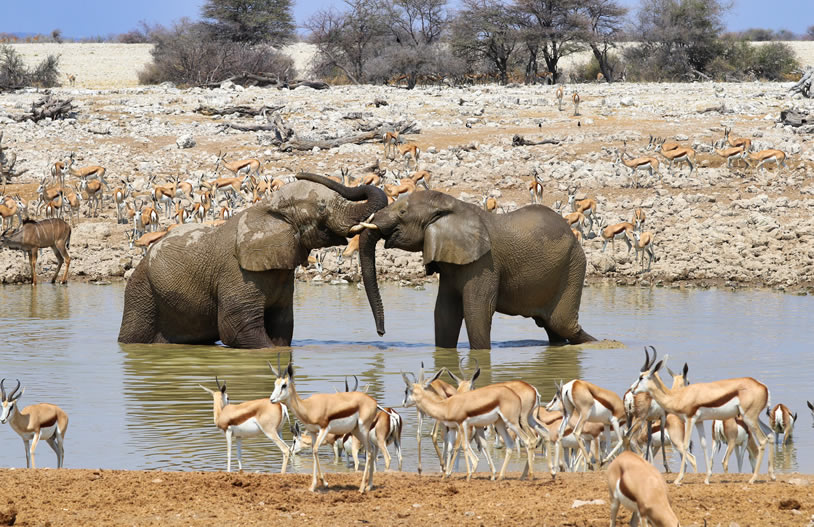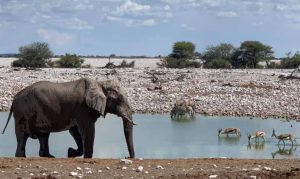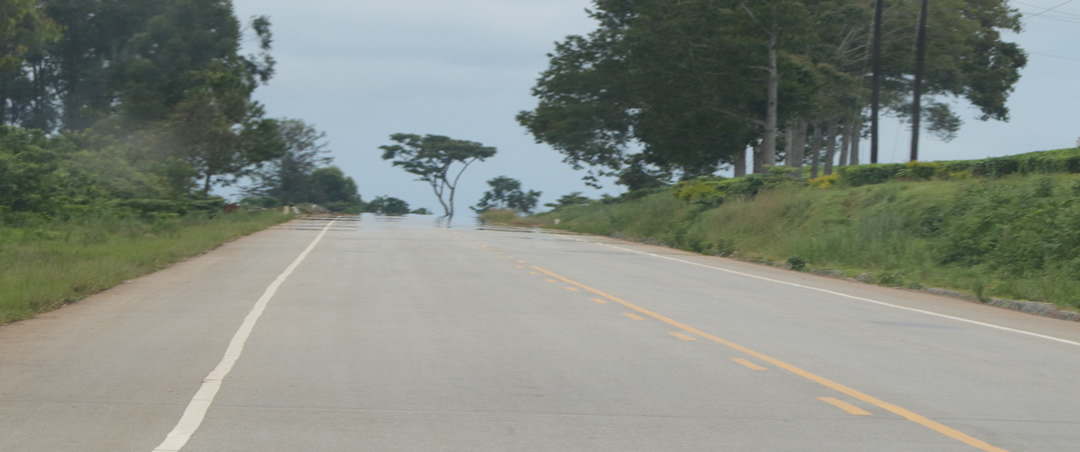
Having visited several national parks across east and southern Africa, I must say that Etosha National Park in Namibia is among my best national parks on the African continent. Amongst all my safari experiences, Etosha has managed to impress me in a unique way.
The enjoyment began as soon as I entered the park through the Von Lindequist Gate in the eastern part of the park. Within seconds of entering the park, I was greeted by the graceful presence of a giraffe. That instant encounter with the giraffe made me know that am going to enjoy my stay in the park. As someone who loves rugged and arid landscapes, the park’s dryness during my visit in August was like a desert dream come true. The bleached yellow grass, the white gravel road, and the clear light blue sky blended together to form a breathtaking desert palette.
Even before reaching the famous Etosha Pan, which is found at the heart of the park, I had already amazed by the park’s stark desert beauty. This vast, glistening salt pan stretches a stunning 130 kilometers in length and up to 50 kilometers in width at certain points, imparting a distinct character to the park itself. The presence of the Etosha Pan further intensified my fascination with the place.
Inside the pan, vegetation is scarce, and during the dry months, the pan fractures into intricate puzzle-like shapes, resembling another planet. On one of my morning game drives in the park, I unexpectedly startled a group of giraffes. They ran across the road and onto the pan. Intrigued, I stopped my 4×4 and watched them walk off into the distance, becoming the sole vertical lines visible for miles as if strolling toward the edge of the world.
Given the immense size of Etosha National Park, spanning 22,000 kilometers (even larger than Kruger National Park in South Africa), I understood the importance of embracing a laid-back pace rather than rushing through the park.
Starting from Namutoni, the camp located at the easternmost part of the park, I spent the initial few nights there. Then, I slowly proceeded westward, making stops at Chudob, Kalkheuwel, Ngobib, Goas, and Naumses waterholes along the way. After a delightful stay at Halali’s campsite, I continued with my safari to the last camp, Okaukeujo, passing through the waterholes of Homob, Aus, Olifantsbad, and Gemsbokvlakte.
Spotting wildlife in Etosha National Park during the dry season of the year is astonishingly effortless. With the scarcity of water in the park due to the dry season, animals are forced to gather at waterholes to quench their thirst. My game drive strategy involved waking up in the morning, leaving the campsite as the park gates open and heading to a waterhole, parking my vehicle, and getting ready with a thermos of tea and my camera ready to fire.
 Upon arrival, I would either witness ongoing activity at the waterhole or witness something interesting within minutes. Perhaps a serene lioness gracefully maneuvering between vehicles to drink some water, zebras engaged in playful tussles, a small herd of elephants and their adorable babies drinking together, or a captivating standoff between groups of gemsbok and wildebeest competing for access to the waterhole.
Upon arrival, I would either witness ongoing activity at the waterhole or witness something interesting within minutes. Perhaps a serene lioness gracefully maneuvering between vehicles to drink some water, zebras engaged in playful tussles, a small herd of elephants and their adorable babies drinking together, or a captivating standoff between groups of gemsbok and wildebeest competing for access to the waterhole.
Every waterhole became an enthralling spectacle, and even the drives between them presented exciting encounters. For instance, I stumbled upon a leopard peacefully dozing in the embrace of a small tree, just a few meters away from the road at noon.
Indulging in the serene ambiance of the waterholes back at the camps was equally rewarding as the game drives. One memorable experience was watching a rhino and her calf during the early evening at the waterhole in Halali Camp. Oblivious to the safari lovers just a few meters away, eagerly capturing photographs, both of them lingered at the waterhole for some time, creating an enchanting scene.
Among all the waterhole experiences, my favorite moments happened at Okaukeujo. This particular camp, located in the southern part of Etosha National Park, boasts the park’s most famous waterhole, and rightfully so. The camp is found around this huge waterhole, with only a low wall separating tourists from the animals that frequent it. During the daytime, the scene was a cacophony of hundreds of springboks, zebras, and gemsboks all jostling for their turn to drink, creating a vibrant spectacle accompanied by resounding calls and swirling dust.
The late afternoon offered a more interesting experience. As I seated on a bench with a refreshing Windhoek beer, a majestic herd of elephants gracefully made their way towards the waterhole, walking direct to the waterhole. They spent some time drinking, bathing, and having dust baths. Alongside them, a few giraffes, gemboks, and a solitary rhino joined them.
As the sun set, casting the sky in hues of neon pink and tangerine, radiant beams of light caught the dust swirling in the air, creating a truly magical scene. I will forever cherish that unforgettable afternoon at the waterhole in Okaukeujo, just as the memories of my winter safari in Etosha will forever be etched in my heart.
Etosha National Park, with its abundant wildlife encounters, left me in awe, providing unforgettable moments both on the road and within the tranquil atmosphere surrounding the waterholes.


